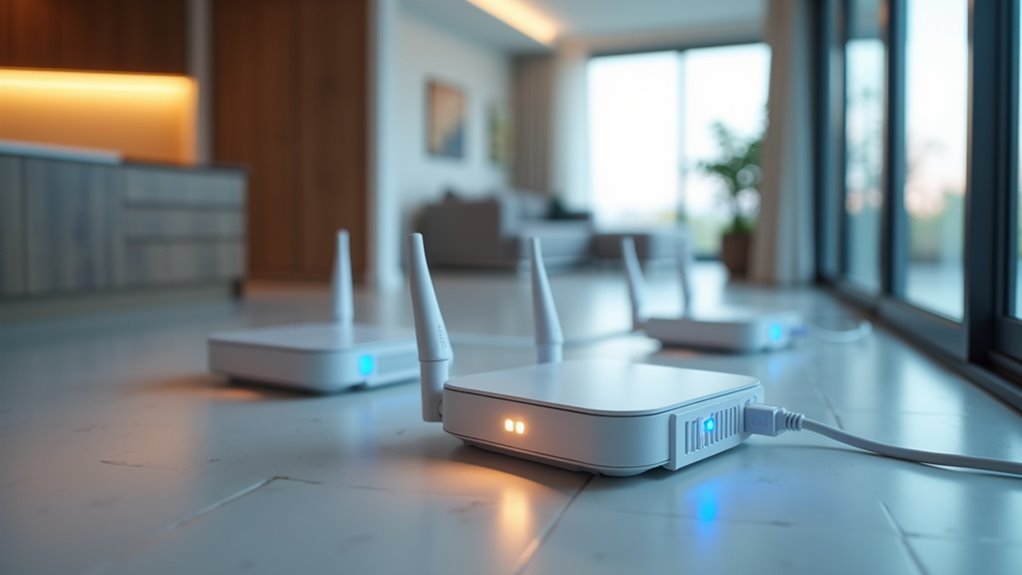You’re probably settling for disappointing Wi-Fi speeds in your apartment because you don’t understand how mesh networks can transform your connectivity. Most people make critical mistakes when positioning nodes, selecting bands, and configuring backhaul connections that leave them with frustrating dead zones and sluggish performance. There’s a specific methodology that networking professionals use to maximize coverage and eliminate interference—strategies that’ll dramatically change how you experience internet throughout your entire living space.
Understanding Mesh Network Backhaul Connections

When you’re setting up a mesh network in your apartment, understanding backhaul connections becomes essential for maximizing your wifi performance.
Backhaul forms the backbone connecting your access points, enabling seamless communication between nodes throughout your space.
Backhaul serves as your mesh network’s communication highway, linking nodes together for optimal wifi performance throughout your home.
You’ll encounter two main types of mesh systems: dual-band and tri-band.
Dual-band systems use Wi-Fi for backhaul when Ethernet isn’t available, typically reducing bandwidth by half.
Tri-band systems include dedicated backhaul radios, delivering superior performance without bandwidth penalties.
Strategic node placement directly impacts your backhaul effectiveness.
Placing nodes too far apart weakens backhaul bandwidth, while positioning them too close interferes with device roaming.
Apps like Multy X help optimize node placement, ensuring robust backhaul connections and extensive coverage throughout your apartment.
Choosing the Right Mesh System for Small Spaces
When you’re selecting a mesh system for your apartment, you’ll need to decide between dual-band and tri-band options based on how many devices you’ll connect.
Your node placement strategy becomes essential in smaller spaces since you can’t simply scatter units everywhere without considering interference and ideal coverage patterns.
You’ll also face the classic trade-off between budget constraints and performance expectations, so understanding which features matter most for your specific living situation will guide your decision.
Dual Vs Tri-Band
Since you’re shopping for a mesh system to maximize your apartment’s wifi performance, you’ll need to decide between dual-band and tri-band options.
Dual-band mesh systems operate on 2.4GHz and 5GHz frequencies, effectively covering up to 2,500 square feet—perfect for most apartments. They’ll handle your everyday streaming, browsing, and smart home needs without breaking the bank.
Tri-band systems add a dedicated 5GHz backhaul band, reducing congestion and improving performance when you’ve got many connected devices competing for bandwidth.
If you’re running more than 20 connected devices or have heavy bandwidth demands like 4K streaming and gaming, tri-band systems excel at managing network traffic.
For typical apartment living with fewer devices, dual-band offers excellent value and reliable performance at a lower cost than tri-band alternatives.
Node Placement Strategy
After selecting your mesh system, proper node placement becomes your key to revealing maximum wifi performance in your apartment. Your node placement strategy determines whether you’ll experience seamless connectivity or frustrating dead zones throughout your space.
| Zone | Primary Node | Secondary Node | Distance |
|---|---|---|---|
| Living Area | Central location | Near TV/office | 30-40 feet |
| Bedroom | Hallway position | Master bedroom | 35-45 feet |
| Kitchen | Dining room | Counter area | 25-35 feet |
| Office | Main room | Work corner | 40-50 feet |
| Bathroom | Adjacent hallway | Not needed | N/A |
Position your primary node centrally to optimize signal distribution. Use apps like Multy X to analyze signal strength and identify weak coverage areas. Your mesh network performs best when nodes stay 30-50 feet apart, preventing interference while maintaining strong backhaul communication.
Budget Vs Performance
Finding the right mesh system for your apartment means balancing cost against performance needs without overspending on features you’ll never use.
Budget-friendly mesh systems like the TP-Link Deco M5 offer excellent value at around $150 for a three-pack, delivering reliable coverage for most small spaces without breaking the bank.
You don’t need enterprise-grade features for apartment living. Focus on systems that handle your device count—up to 50 connected devices works perfectly for smart homes with multiple streaming devices, phones, and IoT gadgets.
Look for automatic security updates and quick app-based setup processes that save you time and technical headaches.
Consider coverage area realistically. Systems covering 5,000 square feet exceed most apartment needs, so you’re often paying for unnecessary range when simpler solutions provide identical performance.
Strategic Node Placement for Maximum Coverage
You’ll want to position your primary router in a central location within your apartment to guarantee even signal distribution throughout all rooms.
Keep your mesh nodes within 30 feet of each other and away from signal-blocking materials like brick walls or metal appliances that can interfere with wireless transmission.
Test different node configurations and use smartphone apps to measure signal strength, helping you find the sweet spot that eliminates dead zones while maintaining strong backhaul connections.
Central Router Positioning
Three strategic factors determine whether your router placement will make or break your apartment’s Wi-Fi performance.
First, position your central router in a high, unobstructed location within your apartment’s most central room. This minimizes distance to all areas and maximizes your Wi-Fi signal distribution throughout every corner.
Second, keep your mesh router system away from signal-killing obstacles like large metal objects, microwaves, and TVs that interfere with wireless transmission. These devices create dead zones that’ll cripple your network’s effectiveness.
Third, don’t let your internet source location dictate router placement. Use Ethernet cables or powerline adapters to connect your router wherever it’ll perform best.
Conduct regular speed tests from different rooms and adjust positioning based on real performance data, not guesswork.
Avoiding Signal Interference
Once you’ve positioned your central router, strategic mesh node placement becomes critical for eliminating dead zones and achieving blanket coverage throughout your apartment. Signal interference can dramatically reduce your mesh Wi-Fi performance, so you’ll need to identify and avoid common culprits.
Keep nodes 30-50 feet apart to prevent roaming issues while maintaining strong backhaul connections. Electronic devices, microwaves, and metal objects emit interference that weakens signals, particularly on the 2.4GHz band. Position nodes in elevated, central locations away from these sources.
| Interference Source | Frequency Band | Recommended Distance |
|---|---|---|
| Microwave ovens | 2.4GHz | 10+ feet |
| Bluetooth devices | 2.4GHz | 6+ feet |
| Metal objects | All bands | 3+ feet |
| Baby monitors | 2.4GHz | 8+ feet |
Building materials like concrete and brick require additional nodes to penetrate Wi-Fi dead zones effectively.
Optimal Node Distance
While interference avoidance sets the foundation, achieving the ideal 30-foot spacing between mesh nodes creates the backbone of your apartment’s wireless coverage.
Optimal node placement at this distance maintains strong signal strength while preventing bandwidth reduction that occurs when nodes are positioned too closely together.
You’ll want to map your apartment’s layout before positioning nodes, considering walls and large furniture that can weaken signals.
Metal appliances and brick construction materials create particular challenges for wireless transmission. Use apps like Multy X to guide your placement decisions and identify potential dead zones.
After installation, run speed tests at each node location to verify performance.
If you discover weak spots, adjust positioning accordingly to guarantee every corner of your apartment receives a strong signal throughout your network.
Optimizing Router Position in Central Locations
The heartbeat of your apartment’s Wi-Fi network lies in strategic router placement. You’ll maximize Wi-Fi signal distribution by positioning your main router in a central location, reducing physical barriers like walls and furniture that weaken connectivity.
This strategic placement becomes even more critical when establishing your mesh network foundation.
If your current router placement isn’t ideal, you can run long Ethernet cables or use power line adapters to relocate it effectively. Test Wi-Fi speeds from different rooms to identify the most effective position for improved performance.
For larger apartments, implement a mesh network system with multiple access points while maintaining that central connection point. This approach guarantees thorough coverage while keeping your primary router strategically positioned for maximum efficiency.
Managing Wi-Fi Channels and Band Selection

After positioning your router efficiently, you’ll need to tackle channel interference and configure your dual-band settings for maximum performance.
Crowded Wi-Fi channels in apartment buildings can drastically slow your connection, but switching to less congested channels often provides immediate speed improvements.
Your dual-band router’s 2.4GHz and 5GHz frequencies each serve different purposes, and proper configuration guarantees you’re getting the best performance from both bands.
Channel Interference Troubleshooting
When your apartment Wi-Fi crawls at frustrating speeds, channel interference often serves as the hidden culprit behind your connectivity woes.
You’ll need to identify which Wi-Fi channels are overcrowded in your building and make strategic adjustments.
Start by accessing your router’s settings and switching to less congested channels. For 2.4GHz networks, stick to channels 1, 6, or 11 since they don’t overlap with neighboring signals.
Dual-band routers give you more flexibility—use 2.4GHz for range and 5GHz for speed.
Run speed tests before and after channel changes to confirm improvements.
If manual adjustments feel overwhelming, enable your router’s automatic channel selection feature, which dynamically chooses ideal channels based on real-time network conditions.
Dual-Band Router Configuration
Modern dual-band routers reveal significant performance gains by broadcasting on both 2.4GHz and 5GHz frequencies simultaneously, giving you strategic control over your apartment’s Wi-Fi environment.
You’ll find the 2.4GHz band provides wider coverage for basic devices, while 5GHz delivers faster speeds for streaming and gaming within shorter ranges.
Access your router’s settings to manage Wi-Fi bands effectively. Switch devices between channels to reduce interference from neighboring networks that crowd the same frequencies.
You can manually assign bandwidth-hungry devices like laptops and smart TVs to the 5GHz band, while connecting IoT devices and older equipment to 2.4GHz.
Regular channel adjustments on both bands eliminate congestion and boost performance.
Your dual-band router automatically enables seamless band switching based on device proximity and bandwidth requirements.
Setting Up Antennas for Better Signal Distribution
Since most routers come with adjustable antennas, you can greatly improve your apartment’s Wi-Fi coverage by positioning them strategically.
Position antennas perpendicularly to each other—one horizontal and one vertical—to enhance signal coverage throughout your living space. Don’t point all antennas in the same direction, as this limits your wireless signal’s effective range and distribution.
Experiment with different antenna angles and orientations. Slight adjustments can notably impact your signal’s strength and reach. Each apartment’s layout affects antenna performance differently, so you’ll need to test various configurations.
Conduct speed tests after each adjustment to identify the most effective setup for your specific space.
Additionally, regularly update your router’s firmware to improve antenna performance and maintain ideal network stability.
Minimizing Electronic Interference in Apartments

You’ll need to identify the electronic devices and physical obstacles that’re blocking your Wi-Fi signal throughout your apartment.
Strategic placement of your router away from interference sources can dramatically improve your connection quality and coverage area.
Understanding which frequency bands work best in your specific environment will help you optimize your network’s performance.
Identify Common Signal Blockers
When you’re troubleshooting weak Wi-Fi in your apartment, understanding what blocks your signal is the first step toward better coverage.
Signal blockers create frustrating dead zones and slow your internet to a crawl.
Here are four common culprits weakening your Wi-Fi signals:
- Large metal objects – Refrigerators, filing cabinets, and metal shelving reflect or absorb signals, creating significant interference.
- Thick walls – Brick and concrete construction materials act as barriers, reducing signal strength between rooms.
- Electronic devices – Microwaves, cordless phones, and Bluetooth gadgets operating on 2.4GHz frequency cause signal degradation.
- Bulky furniture – Entertainment centers, aquariums, and dense cabinets obstruct signal paths and create coverage gaps.
Identifying these obstacles helps you strategically position your router for peak performance.
Strategic Router Placement Tips
Three strategic decisions about your router’s location can dramatically improve your apartment’s Wi-Fi performance.
First, position your router centrally and elevate it to maximize signal distribution throughout your space. This strategic router placement eliminates dead spots that typically plague corner locations.
Second, maintain distance from interference sources like microwaves and cordless phones, which disrupt the 2.4GHz band your Wi-Fi network relies on. These devices create signal conflicts that slow your connection.
Third, avoid placing your router behind metal objects or large furniture that block signals. Instead, choose an open area with clear sightlines.
For dual-band routers, experiment with antenna positioning—try one horizontal and one vertical. This configuration optimizes coverage patterns and strengthens your overall Wi-Fi network performance across different areas of your apartment.
Frequency Band Selection Guide
The invisible battlefield of competing wireless signals in apartment buildings makes frequency band selection your most powerful weapon against slow internet speeds.
You’ll transform your connectivity by understanding which frequencies work best in crowded residential environments.
Strategic Frequency Band Selection:
- Switch to 5GHz frequency band – You’ll get considerably faster data rates despite shorter range compared to slower 2.4GHz networks that blanket wider areas.
- Choose less crowded channels – Scan within the 5GHz spectrum to find channels with minimal interference from neighboring networks.
- Position away from electronics – Keep your router distant from microwaves and cordless phones operating on congested 2.4GHz frequencies.
- Invest in dual-band routers – You’ll enable simultaneous broadcasting on both bands, letting devices automatically connect to ideal frequencies.
Using Apps for Seamless Network Management
How can you transform your apartment’s Wi-Fi management from a technical headache into a simple, intuitive experience?
Modern apps like Multy X revolutionize network management by eliminating the need for advanced technical knowledge. These intelligent applications streamline your Wi-Fi system setup and ongoing maintenance through user-friendly interfaces.
You’ll gain powerful control features including parental controls, guest network creation, and real-time performance monitoring.
Voice integration with Amazon Alexa lets you manage settings through simple commands—check internet speeds or toggle guest networks instantly.
These apps identify bandwidth-hogging devices, helping you optimize performance for critical applications.
Additionally, they automate firmware updates across all mesh nodes, ensuring your network stays secure and performs at peak efficiency with minimal effort.
Configuring Smooth Device Roaming Between Nodes
Beyond streamlined management, your mesh network’s true potential emerges when devices move effortlessly between nodes without dropping connections or experiencing lag.
Configuring smooth device roaming transforms your apartment into a seamless connectivity zone where interruptions become obsolete.
Here’s how to enhance your mesh network for flawless shifts:
- Enable a single SSID across all nodes so devices automatically switch connections as you move throughout your apartment without manual intervention.
- Activate roaming standards like 802.11k, v, and r to greatly reduce connection interruptions during node shifts.
- Configure band steering technology to automatically direct devices to ideal nodes based on signal strength and current network conditions.
- Update firmware regularly to maintain peak roaming capabilities and enhance overall network performance across your mesh system.
Mapping Signal Strength Throughout Your Space
While your mesh network’s roaming capabilities guarantee smooth shifts, you’ll need to understand exactly where your Wi-Fi signal reaches peak strength and where it falters to optimize node placement effectively.
Start mapping your signal strength using software like NetSpot to create visual coverage charts throughout your apartment. Conduct speed tests at multiple locations, identifying dead zones and weak connectivity areas. Your Wi-Fi Mesh System’s performance depends on strategic node placement based on this mapping data.
Analyze how walls and furniture obstruct signals by comparing your existing router’s coverage range to the signal strength map. This visualization reveals exactly where additional mesh nodes will provide maximum benefit.
Voice Control Setup for Network Management
Once you’ve optimized your mesh network placement, voice control integration transforms routine network management into effortless commands you can execute without touching a device.
Compatible mesh systems work seamlessly with Amazon Alexa, enabling hands-free Wi-Fi management throughout your apartment.
Voice control streamlines these essential network management tasks:
- Guest network control – Toggle guest access on or off with simple voice commands
- Speed testing – Run internet performance checks instantly without opening apps
- Device monitoring – Check which devices are connected to your mesh network
- Troubleshooting assistance – Resolve common connectivity issues through voice prompts
This integration eliminates the need to navigate complex web interfaces or smartphone apps for basic adjustments.
You’ll save time on routine network management while gaining immediate feedback on your Wi-Fi performance through convenient voice commands.
Avoiding ISP Router Rental Fees
After setting up your enhanced mesh network with voice control capabilities, you’ll want to eliminate the ongoing expense of ISP router rental fees that can drain $120-$180 from your budget annually.
Avoiding ISP router rental fees starts with purchasing your own mesh system that outperforms basic internet provider equipment while delivering superior coverage throughout your apartment.
Most internet providers allow you to use personal routers without additional charges, making this switch immediately profitable.
Using your own router eliminates rental fees instantly, with most providers supporting personal equipment at no extra cost.
Research compatible routers supporting Wi-Fi 6 standards for peak speed and connectivity. Your mesh system investment pays for itself within months while providing better performance than rental equipment.
Check your internet provider’s policies regularly, as some offer discounts for customers who decline equipment rentals, maximizing your savings potential.
Troubleshooting Dead Zones and Weak Signals
Three critical steps will eliminate dead zones and weak signals that plague apartment Wi-Fi networks.
Start by using NetSpot software to map your Wi-Fi signal strength throughout your space, identifying exactly where coverage drops. This troubleshooting dead zones approach gives you concrete data rather than guesswork.
Your mesh network placement strategy matters greatly. Position nodes centrally and avoid spreading them too far apart, which reduces backhaul bandwidth and creates coverage gaps.
- Map signal strength with Wi-Fi analysis software like NetSpot
- Position mesh nodes centrally to maximize coverage overlap
- Experiment with antenna configurations by positioning them perpendicularly
- Enable roaming standards like 802.11k, v, and r for seamless changes
Regular reboots refresh connections and resolve temporary interference issues affecting your network’s performance.
Upgrading Equipment for Enhanced Performance
When troubleshooting fixes don’t deliver the performance boost you need, hardware upgrades become your most effective solution. Upgrading equipment to newer Wi-Fi 6E routers or investing in a quality mesh network dramatically improves speeds and coverage throughout your apartment.
You’ll save money long-term by purchasing your own router instead of renting from your ISP, while gaining superior performance capabilities.
Mesh network systems like Eero or NETGEAR Orbi excel in apartments, covering up to 5,000 square feet and handling multiple devices seamlessly. These systems eliminate dead zones through strategically placed access points that work together for stable internet coverage.
Don’t forget to update firmware regularly and use Cat6e Ethernet cables or newer to optimize your connection and maintain peak performance across all devices.
Frequently Asked Questions
How Do I Maximize My Mesh Wifi?
Position your mesh nodes strategically to minimize obstructions, use dedicated management apps for optimization, guarantee modern roaming standard support, update firmware regularly, and conduct speed tests to identify weak spots requiring adjustment.
What Is a Major Disadvantage of a Mesh Network?
You’ll face increased latency as data hops between multiple nodes before reaching its destination. This delay can seriously impact your online gaming performance and real-time applications like video calls.
How Do I Improve My Wifi Speed With Mesh?
You’ll improve your wifi speed by positioning mesh nodes strategically throughout your space, updating firmware regularly, and ensuring devices connect to the nearest node for peak performance and reduced interference.
How Do I Expand My Mesh Wifi?
You’ll expand your mesh wifi by adding nodes in weak signal areas between your router and dead zones. Use your mesh app to find ideal placement spots and regularly update firmware for best performance.





Leave a Reply